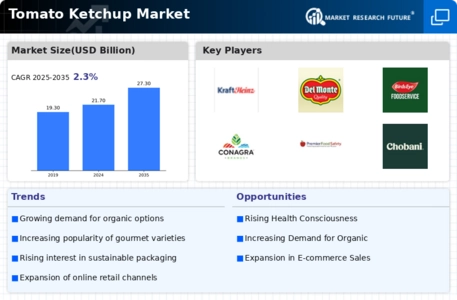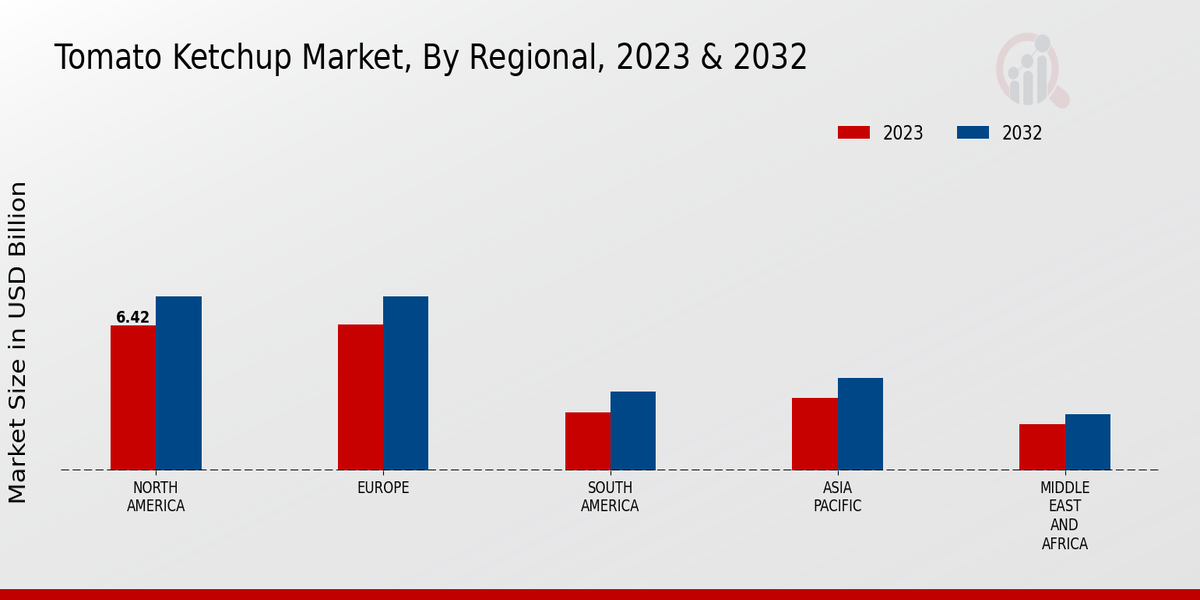Market Growth Projections
The Global Tomato Ketchup Market Industry is poised for growth, with projections indicating a market value of 21.7 USD Billion in 2024 and an anticipated increase to 27.3 USD Billion by 2035. This growth reflects a compound annual growth rate of 2.12% from 2025 to 2035, suggesting a steady expansion in consumer demand. Factors such as rising convenience food consumption, health consciousness, and innovative product offerings contribute to this positive outlook. The market's resilience in adapting to changing consumer preferences and trends further supports these projections, indicating a robust future for the tomato ketchup sector.
Expansion of Retail Channels
The expansion of retail channels significantly influences the Global Tomato Ketchup Market Industry. With the rise of e-commerce and modern retail formats, consumers have greater access to a variety of ketchup products. Supermarkets, hypermarkets, and online platforms are increasingly stocking diverse brands and flavors, catering to a wide range of preferences. This accessibility is likely to enhance market penetration and drive sales growth. As the industry adapts to these retail trends, it may experience a compound annual growth rate of 2.12% from 2025 to 2035, indicating a positive outlook for ketchup consumption across various demographics.
Globalization and Culinary Trends
Globalization plays a pivotal role in shaping the Global Tomato Ketchup Market Industry. As culinary influences cross borders, ketchup is increasingly integrated into diverse cuisines worldwide. This trend not only broadens the consumer base but also encourages innovative flavor combinations that appeal to local tastes. For instance, regions are experimenting with spicy or exotic variations of traditional ketchup, enhancing its appeal. The globalization of food culture suggests that the market could see sustained growth as consumers embrace new flavors and culinary experiences. This dynamic environment may further contribute to the industry's overall expansion in the coming years.
Rising Demand for Convenience Foods
The Global Tomato Ketchup Market Industry experiences a notable surge in demand for convenience foods, driven by changing consumer lifestyles. As more individuals seek quick meal solutions, ketchup serves as a versatile condiment that enhances flavor and convenience. This trend is particularly evident in urban areas where fast-paced living necessitates easy-to-use products. The market is projected to reach 21.7 USD Billion in 2024, indicating a robust growth trajectory. The increasing popularity of ready-to-eat meals and fast food establishments further propels this demand, suggesting that the ketchup market could continue to thrive as consumer preferences evolve.
Sustainability Initiatives in Production
Sustainability initiatives are becoming increasingly relevant in the Global Tomato Ketchup Market Industry. As consumers prioritize environmentally friendly products, manufacturers are adopting sustainable practices in sourcing and production. This includes using organic tomatoes, reducing packaging waste, and implementing eco-friendly manufacturing processes. Such initiatives not only resonate with environmentally conscious consumers but also enhance brand loyalty. The industry's shift towards sustainability may positively impact its growth trajectory, as consumers are likely to support brands that align with their values. This trend indicates a potential for increased market share among companies that prioritize sustainability in their operations.
Health Consciousness and Product Innovation
Health consciousness among consumers is reshaping the Global Tomato Ketchup Market Industry. As individuals become more aware of dietary choices, there is a growing preference for healthier alternatives. This has led to innovations in ketchup formulations, including organic, low-sugar, and reduced-sodium options. Brands are responding by introducing products that align with health trends, thereby attracting a broader consumer base. The market's evolution towards healthier offerings may contribute to its projected growth, with an anticipated value of 27.3 USD Billion by 2035. This shift indicates a potential for sustained growth as manufacturers adapt to changing consumer demands.










